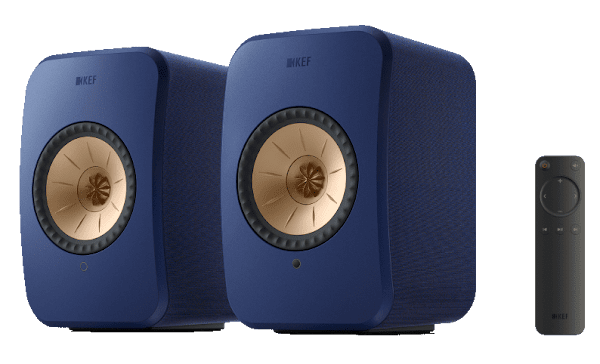This second–gen streaming speaker package is seriously stellar
Almost four years since KEF first miniaturized its excellent LS50 Wireless streaming speaker system into something more handily sized, the company is back with an upgrade.
The LSX II use the same driver arrangement as the outgoing model — it’s the 11th generation of KEF’s remarkable Uni–Q arrangement that positions an aluminum tweeter in the throat of an aluminum mid/bass driver. At 200 Class D watts (30W to each tweeter, 70W to each mid/bass driver), power is unchanged too.
Connectivity is improved, though, and significantly. As well as the Ethernet, digital optical and analog 3.5mm inputs on the left–channel "primary" speaker, there’s now also HDMI ARC and USB–C.
They can be paired wirelessly, but a hard– wired connection is preferable if for no other reason than it allows the LSX II to function at 24bit 96kHz. Paired wirelessly, the speakers max out at 24bit/48kHz — although no matter how you connect them they’re always compatible with MQA and file sizes up to 24bit/384kHz and DSD256.
As far as design goes, there’s virtually nothing to differentiate the LSX II from the model it replaces: only a long stare at the specs sheet reveals any meaningful differences. Mind you, that’s not automatically a bad thing. The original KEF LSX was a good–looker, and just because the design is getting on for four years old that doesn’t mean it’s any less attractive.
At a useful compact 9.5 × 6.1 × 7.1 inches per speaker, the LSX II is simple to position more or less anywhere — as long as you bear in mind each speaker has a rear–facing bass–reflex port, that is. There are some bespoke KEF speaker stands available (the S1) for $350 a pair, as well as the B1 wall bracket ($230) and P1 desk pad ($180) — so your placement options are extensive.
Size isn't everything
Yes, it’s obvious — but it needs saying. The KEF LSX II are not big speakers, and they don’t feature big drivers. So if you’re expecting the sort of scale of audio presentation that can fill a fairly big room with sound, think again.
But as long as you’re not expecting unlikely scale, the rest of the news regarding the way the LSX II performs fluctuates between “very good” and great“. The soundstage they describe is well laid out, easy to understand and allows every element of even a complicated recording a little elbow room in which to do its thing.
As far as tonality is concerned, the LSX II is just slightly warmer than absolutely neutral. It’s not in any way overheated — it almost makes the KEF system sound more accommodating and welcoming than it otherwise would. The speakers don’t dig as deep or hit as hard in the low frequencies as bigger alternatives, but the bass the KEF system produces is nevertheless solid, textured, detailed and really well controlled. The attack and decay of individual bass sounds is straight–edged and convincing.
The midrange is equally accomplished, with the KEF extracting even fine details from a singer’s performance. And the top of the frequency range is almost a mirror image of the bottom: there’s substance, detail and control, all delivered with real energy.
One of the most admirable traits of the KEF Uni–Q driver arrangement is the remarkable stereo focus it delivers. And because the LSX II is so compact, there’s bound to be a temptation to use them on a desktop — and if you do, the Uni–Q comes bounding into its own. The focus and precision of its presentation is really brought into sharp relief by the near–field position — and so the closer you sit to the speakers the more accurate and engrossing their sound.
If you already own a KEF LSX system and you’re not desperate to introduce your TV into its sphere of influence, it’s hard to make a case for upgrading to the LSX II. If you want to fill a pretty big room with sound, you should probably look beyond this system too.
For the rest of us, though, it’s hard to make a case not to investigate it fully — the LSX II is small, expansive in its functionality, features a well–implemented control app, looks the business and sounds the business too.
Features: Uni–Q driver array (0.75in aluminum dome, 4.5in magnesium/aluminum alloy cone), frequency range 49Hz – 47kHz, connectivity: HDMI ARC, USB–C, optical, 3.5mm jack, 2x Ethernet (1x network, 1x interspeaker), AirPlay 2, Google Chromecast, Wi–Fi 5, Bluetooth 4.2. Dimensions: 9.5 × 6.1 × 7.1in. Weight: 15.6lbs
Price: $1,399.99
A great–sounding system with excellent flexibility, and is great value for money.





Comments
Post a Comment